Our journey through Swansea in search of the celebrated Welsh poet, Dylan Thomas, had brought us past the pubs where he drank, past his school and finally to Cwmdonkin Park where he played as a boy. (At this point you may want to read Part 1 of this story in which we visit the Dylan Thomas Centre and walk the city streets listening to Return Journey, Dylan’s account of the pre-war Swansea he knew.)
The reservoir in the park, where the swans once glided is now a flat stretch of grass with a children’s playground at one end, but I imagine that the bowling green and pavilion looks much as they did in Dylan’s childhood. After the Return Journey performance we stopped at the cafe, which serves homemade lemonade and ice cream, although we stuck to the tea and Welsh cakes. From here it was just a stroll across the park to our next destination in the search for Dylan Thomas, at the house where he was born, 5 Cwmdonkin Drive.
The Dylan Thomas birthplace has been restored and is open to the public, not so much as a museum but as a recreation of the Thomas family home, as if they had just stepped out leaving us to peep into their domestic arrangements. You can even stay in the house, entertained by books, games and an old gramophone player, but you’ll have to do without the flat screen TV although thankfully there is central heating. We had arranged to meet the owner and curator of the Dylan Thomas Birthplace, Geoff Haden, who kindly gave us a personal tour of the house.
This article may contain affiliate links that provide commission on purchases you make at no extra cost to you. As an Amazon Associate I earn from qualifying purchases.
The Thomas family bought 5 Cwmdonkin Drive in August 1914 when it was newly built and Dylan was born in the upstairs front bedroom in the October of that year. It was the sort of house that a bank manager or doctor might have owned and fitted with the aspirations of DJ Thomas who had hoped for higher things than a school master of the grammar school. The house cost £500 and Mrs Thomas was able to contribute £150 that she had inherited from her father.
Dylan’s mother Florence was keen to have a modern house with mains drainage to provide a healthy home for her children, 8 year old Nancy and new baby Dylan and the bathroom with plumbing and separate upstairs lavatory would have been considered very genteel at the time. The Thomas family lived at 5 Cwmdonkin Drive for 23 years and when they retired to Laugharne they were able to rent it out to provide some additional income. After the house was sold, it was over the years a family home, student bedsits and was leased by Swansea Council who eventually gave it up to concentrate on developing the Dylan Thomas Centre in the Marina.
Geoff told me how he was passing one day and knocked on the door, “This was the birthplace of the most famous person in Wales and yet it was a student bedsit, and if you were looking for a student house this would be number 10 on your list”. When the council gave up the lease in 2004, Geoff decided to take it over and using his experience as a structural engineer, spent 3 years restoring the house to the condition it might have been when Dylan Thomas was born there in 2014.
In order to bring it back to the appearance of Dylan’s childhood, Geoff enlisted the help of the Thomas family’s former maid Emily, who was just 15, about the same age as Dylan, when she worked there. She had a very happy time working for the family and kept in touch with them after she left their employment to get married. She told stories of having mock fights with Dylan, armed with a fly-swatter and since she was about the same size, was the model for pullovers that his mother knitted for him.
Since the Thomas family left 5 Cwmdonkin Drive, little had been done to modernise the house, so Geoff was able to restore many of the original features. The original paintwork was discovered under layers of wallpaper and colour schemes were recreated with Emily’s help and through reference to letters and stories that Dylan had written. The dark green walls and deep red William Morris curtains of the front sitting room that was only used for ‘best’ recalled the Victorian era and would have been typical of a conservative family of the period.
Dylan features the sitting room in the scene from “A Child’s Christmas in Wales” in which the fat uncles snore in front of the fire after the Christmas Day lunch. Geoff managed to find all the furniture from within 20 miles of the house, from car boot sales, auctions and house clearances, since few people want the kind of furniture their grandparents used.
The front of the house looks towards Cwmdonkin Park and young Dylan would jump over the fence into the field and take a short-cut into the park. We moved upstairs to look at Dylan’s bedroom, which he joked was so small that he had to go outside to think. The single bed along the wall was wedged up against the fireplace, making it unusable, with a small desk in the corner with the pictures and posters that a teenage Dylan might have kept around him.
This is a recent addition and the result of extensive research by Matthew Hughes who covers marketing for the house as well as conducting tours. I felt touched that the messy desk with posters covering every spare wall-space reminded me of my own teenage son’s bedroom (minus the beer and cigarettes). Here was Shakespeare next to Greta Garbo, a bottle of Hancock’s Mild Ale and a packet of Woodbines on the table sharing space on the crowded desk with his notebooks and a copy of the Koran given by his friend Daniel Jones. His tweed jacket and checked shirt were thrown over the back of the chair, with a copy of the Telegraph that his mother would bring him with breakfast in bed.
This is where Dylan would have written most of his poems until he left home at the age of 20, including his first book “18 Poems” which was published in 1934. Dylan was doted on by his mother, Florence and perhaps it’s no coincidence that the year his parents moved out of 5 Cwmdonkin Drive was also the year he married his wife Caitlin, replacing the Cwtch (a Welsh word meaning cosy, warm and secure) of his family home with a wife to look after him.
Next door, older sister Nancy’s room was decorated in Edwardian style of pale yellow with tiny floral curtains, Welsh blankets and eiderdowns on the beds. It brought back memories of staying at my own grandparents as a little girl, snuggling up in a big bed with my sisters, in a house with no central heating. Geoff said that many of his visitors feel moved by childhood memories when they visit the house.
When Prince Charles came to visit, he couldn’t help stroking the quilted floral eiderdown too, saying it reminded him of his own grandmother’s house. “It took me a moment to realise that he was talking about the Queen Mother” Geoff told me. In the back bedroom, where Dylan’s parents slept, Geoff had opened up the side window that had been bricked up after bomb damage during the war.
From here Dylan could look down the hill towards “the misty sea where ships sailed across the rooftops” and in an early poem he talks of “Leaning from windows over a length of lawns, on tumbling hills admiring the sea.” In DJ Thomas’ downstairs study, Geoff played us a video introduction about the house that President Jimmy Carter, a longtime fan of Dylan Thomas, had recorded when Geoff travelled to visit him in Atlanta. At the back of the house, the kitchen had been restored with its pantries and cupboards, although a modern cooker has been installed as a concession for guests staying in the house.
Beyond is a small garden which Dylan described as “sufficiently large for a wash-house, clothes line, deck-chair, and three sparrows”. He uses it as a scene from his short story “Patricia, Edith and Arnold” in which two maids gossiping over the wall in the back garden discover they are both being courted by the same man, who they go to confront in Cwmdonkin Park.
By the end of our tour of 5 Cwmdonkin Drive we’d had a fascinating insight into Dylan Thomas’ family life in Swansea where he wrote two thirds of his published work. Those who met him often commented on how polite and well mannered he was, a result of his loving and stable middle-class upbringing. While he loved to mix with all classes in the pub and in London he lived the Bohemian lifestyle, he was essentially that Grammar School boy and his time in Swansea was one of the most creative in his life.
Visitor Information
You can visit the Dylan Thomas Birthplace at 5 Cwmdonkin Drive, Uplands, Swansea for a guided tour at 11am, 1pm, 3pm but it’s best to ring ahead to confirm as the house sometimes has guests or is used for events. Price £8. If you are passing the house there is an information notice and you can always ring the phone number to check if you can have a tour. The house can also be booked for overnight stays from £150 and there are regular events such as Dinner with Dylan that are ideal for group visits.
Articles and Videos about the house
Video about 5 Cwmdonkin Drive with music from Osian Guardian article: House of the rhyming son
South Wales Evening Post: Jimmy Carter records a special message for Dylan Thomas fans
BBC News article: Dylan Thomas’ Swansea Childhood bedroom opens
Swansea’s Maritime Quarter
Geoff kindly gave us a lift back to the Dylan Thomas Centre and Maritime Quarter where we had a final hour or two enjoying the afternoon sunshine. On Saturday afternoon the locals were out in force, strolling around standing in the sun with pints in hand and we joined them sunning ourselves in the cafe of the National Waterfront Museum with tables outside overlooking the Marina. I noticed the Dylan Thomas Theatre nearby with murals of many of his characters on the outside, including blind Captain Cat from Under Milkwood.
Dylan was a keen amateur actor, performing with the Swansea Little Theatre who rehearsed in Mumbles, although Dylan was often distracted by the refreshment offered by the local pubs. I also spotted the statue of Dylan Thomas by John Doubleday and elbowed away drinkers from the nearby pub who were using it to rest their pints, so that I could have my photo taken with Dylan.
By the end of our day in Swansea I was entranced by the stories of the city’s most celebrated poet and felt I had glimpsed the childhood stories behind his work. Swansea may not be the prettiest of towns, but if you’re a Dylan Thomas fan it’s definitely worth a visit to soak up the places and people that inspired him.
Read Part 1 of this story, in which we spend the morning visiting the Dylan Thomas Centre and follow the Promenade Performance of Return Journey, stopping at all the places that Dylan Thomas knew. Coming up next on the Dylan Thomas trail … our visit to Laugharne, the pretty village in Carmarthenshire where Dylan Thomas lived with his family in the last few years of his life.
For more information on everything to see and do in Wales check the official website at Visit Wales – also on Twitter and Facebook
For more information about Dylan Thomas on the official Dylan Thomas Website and about the events happening for the Dylan Thomas centenary year on the Dylan Thomas 100 website. For more information about things to do in and around Swansea including the Dylan Thomas attractions visit the Visit Swansea Bay website
All my articles about Dylan Thomas
An ugly lovely town Part 1 – a Return Journey to Swansea with Dylan Thomas
An ugly lovely Town Part 2 – the Dylan Thomas birthplace in Swansea
Lovely Laugharne – on the Dylan Thomas Trail in South Wales
We stayed at Morgans Hotel in Swansea
While in Swansea we stayed at Morgans Hotel, that has been converted from the Harbour Trust Office. The building was completed in 1902 and is a grand reflection of the confident Edwardian era when Britain ruled the waves and Swansea was a great port and industrial powerhouse, known as “Copperopolis” due to the large amount of Copper smelted there. Our large corner bedroom looked as if it had once been an executive office with high ceilings and plaster mouldings and was named Sketty Belle after one of the Swansea ships of the period. Heavy mahogany doors and arched windows were complemented by a pale green colour scheme with cream brocade curtains.
The bedroom was well equipped with fridge, kettle and trouser press and an enormous dark wood TV stand. The bathroom was full of marble and limestone, with a brilliant rainforest shower over the bath, although the glass shower screens made it a bit awkward to lie down in the bath. Lots of nice Molton Brown toiletries made us feel very pampered. Downstairs at the entrance was a very stylish bar area with leather sofas, ideal for a cocktail or pre-dinner drink. The restaurant upstairs where we had breakfast was in a magnificent room, formerly the banking hall of the Harbour Port Office, with original maritime mural over the entrance and copper globe lamps which recalled Swansea’s industrial heyday. I’d highly recommend Morgans Hotel as a place to stay if you’re looking for a luxurious hotel as a base for exploring Swansea and the Dylan Thomas trail.
Morgans Hotel, Somerset Place, Swansea, SA1 1RR. Book online or phone 01792 484848. The Sketty Belle room £175 per night, other rooms from £125 or from £90 in the adjoining townhouse
Our thanks to Visit Wales who hosted* our weekend in Wales discovering Dylan Thomas
* More info on my policies page
This article is originally published at Heatheronhertravels.com


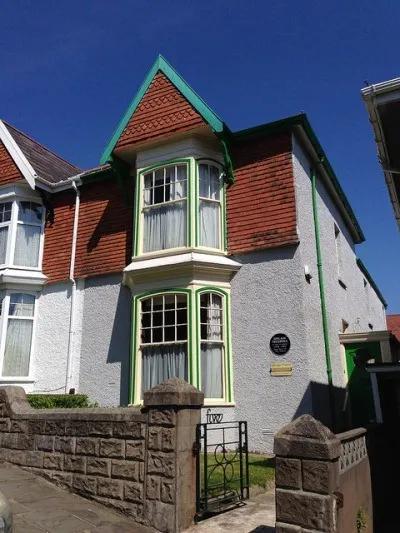
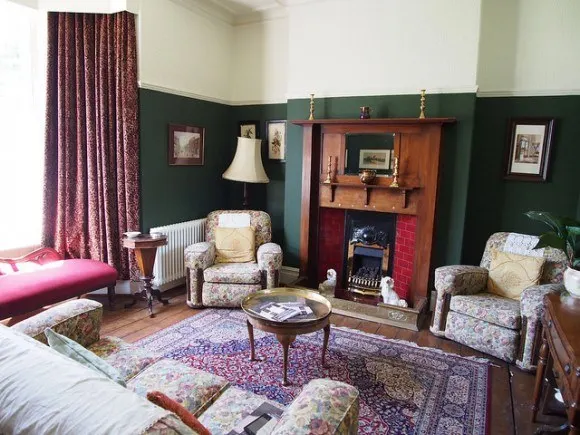
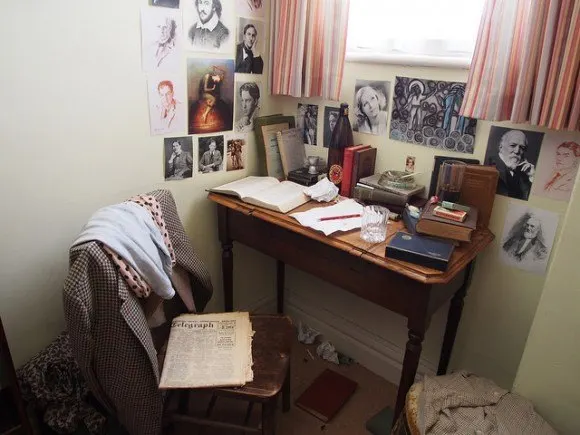
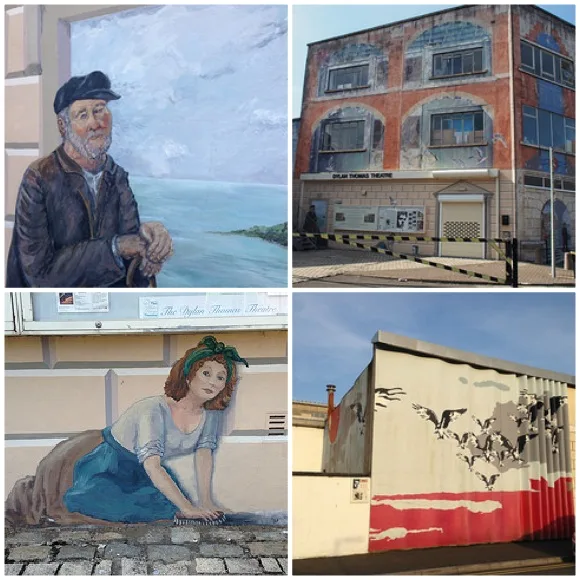
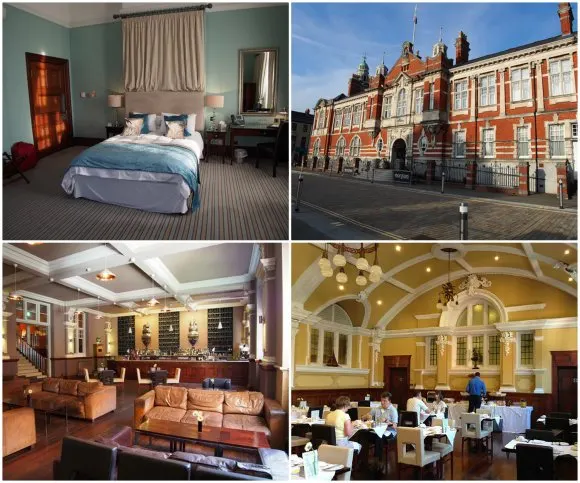

Peter
Thursday 26th of June 2014
Hi Heather,you have shared some nice information about the city, but I don't think it was that much of ugly.... ;) The hotel was nice..
Heather Cowper
Thursday 26th of June 2014
@Peter You're right, Swansea has a lot more to offer than I thought, especially the Dylan Thomas connections which are fascinating